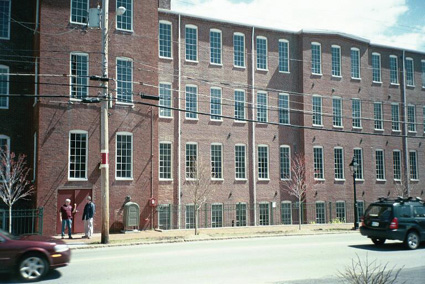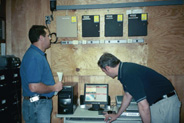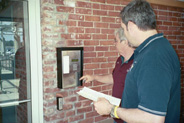|
|

|
|
A security system can optimize building management systems by tying their performance more closely to where people are -- and are not -- in the building. (Photo by Compass Technologies) |
By Kenneth D. Spalding
The Towle Office Complex is in Newburyport, MA, the United States, a beautiful oceanside city of nearly 17,000 in the Northeast of the state. The First Republic Corporation of America (New York, NY) owns the prosperous, upscale complex, an elaborate renovation of several old brick factory buildings.
Towle Manufacturing, the renowned silversmith, sold the property in the mid-1980¡¯s, moving its heavy presses and other manufacturing gear to Puerto Rico.
The conversion began in 1997, with the first tenants moving in to the building in 1999. The complex is a total of 92,000 sq ft, four, three and one story towers with more height added in the center tower.
THE INCEPTION OF ACCESS CONTROL
Mobility Services International (MSI) was one of the first tenants to move into the Towle building. Flextime work hours, frequent weekend projects and a growing (changing) work force, convinced MSI¡¯s management for the need of a modern access control system.
Electronic Security Group (ESG) of Worcester, MA successfully bid the project and was responsible for the installation. ESG is a systems integrator for Compass Technologies access control and security management systems.
The initial system was so successful that the owners decided to protect the entire complex and its eight-plus tenants with an expanded Compass 5E access control system designed and installed by ESG. This included elevators, base building and perimeter doors. Cameras were located at the card reader at the building¡¯s main entrance.
IN OPERATION 24/7
Some office buildings have very few people who walk in off the street, but the Towle Complex has many. With medical, dialysis and acupuncture offices, people are continually coming and going.
The system is designed to ¡®time out¡¯ the building. That is, it is in operation 24/7, but set up to open the doors automatically at 5 am and close at 9 pm.
Most of the tenants stay within that timeframe of opening and closing. But they all have keycards, which allow them access at any time, after hours or on the weekend.
The maintenance office is equipped with a screen and printout capabilities, so building personnel always know who is in the building.
VARIED FACILITY USAGE
Kieran ¡°Bob¡± Maunsell, president of Electronic Security Group, the access control system integrator, points out that by the nature of the manufacturing-plant-turned-office-complex, everyone does not use the main lobby, and everyone does not use the buildings¡¯sthree elevators. Several tenants are essentially in separate but connected spaces.
John Martin, real estate portfolio manager from First Republic, notes that return on investment is a major benefit of the Compass system. With a leased system the expense goes on and on, and hiring security guards would also be more costly than a purchased system.
¡°With Compass, we buy the system, implement it in our various locations, and know that we have excellent access control and security. If we hired a security company to do what the Compass system does, it would be much more costly,¡± he says.
MORE ABOUT ACCESS CONTROL SECURITY SYSTEMS
Access control is often the primary system selected to provide electronic security, with closed-circuit TV and intrusion monitoring as backup systems. A facility manager looking at securing a facility has done a vulnerability assessment, and knows what the building¡¯s vulnerabilities are and what most needs protection.
Considering the various electronic security disciplines commonly available, the manager will probably conclude that no one discipline will do the entire job. There¡¯s a place for each of them. CCTV and other monitoring systems are good deterrents and also provide value from an investigative standpoint after the fact. But access control is unique.
First, it has a direct connection to the physical building: in its most basic form it locks and unlocks doors. Beyond that, it is database-driven and people-driven, offering information about employees, visitors, contractors and vendors. In addition it is PC-based, usually employing a high-capability program.
The action-based access control discipline, tied fundamentally to the building, offers all the possibilities of its active database. This gives it very useful commonalities with building management systems.
|
 
|
|
Access control can optimize building management systems and the integration of access control and building management can save thousands of dollars a month in energy costs. (Photo by Compass Technologies) |
KINDRED SPIRITS
Access control and building management, which includes HVAC, lighting, elevators, etc., are, in a sense, closely related kindred spirits. The building management system controls environmental functions within a building, usually as they relate to the physical whereabouts or movement of people within the building. Access control also controls the physical whereabouts or movement of people within the building.
This is where facility managers can make some important cross-connections. The security system can be leveraged to increase its value and usability. It can optimize building management systems by tying their performance more closely to where people are -- and are not -- in the building.
EXPERIENCE-PROVED
The resulting interconnection/integration between building management and access control has been used in projects that have saved thousands of dollars a month in energy costs. This is accomplished by simply relating the people in the building to the usage of heating, ventilating, air conditioning (HVAC) and lighting. The key is the access control database and the various authorizations given to people covered in the database.
People who regularly work in the building, and those who enter the building off-hours, use a PC-based credential to get in, and often to get from place to place within the building. Through the database, the access control system knows who they are, if they¡¯re authorized to be in the building, where they can legitimately be and for how long. That information, integrated with building energy systems, can lead to worthwhile savings.
For example, management would prefer to reduce heating and lighting at night and on weekends and holidays. But in a multi-tenanted building or a large single-tenant building, some tenants or departments want access to their facilities off hours. With the appropriate interconnection/integration of access control and building facilities, there¡¯s no need to light and heat or air condition the entire building in order to accommodate just a few people.
Employee authorization for access to the building during non-standard business hours is noted in the database. When authorized employees show up, the access control system will be prepared to let them in and open the elevator doors for them, but they will only be able to get out at their specified floors. If the facility also employs CCTV, this can be integrated with the other systems for a further check on people entering and moving around.
With the people moving into place, the access control PC communicates with the energy management system, which turns on the utilities needed for the amount of time allocated. If some people need more time, the system can be set up so a card swipe authorizes an extension of hours.
LOW TECH OR HIGH
The connection between systems can be low-tech, done with relays, or as sophisticated as a direct connection over the building¡¯s local or wide area network.
Most integration between access control and elevators, for example, is done with relays. But a good access control system also has the ability to go high-tech, so the desired integration could be done through some other mechanism such as the building¡¯s infrastructure network.
A TYPICAL ACCESS CONTROL SYSTEM
The Compass 6E high-performance, PC-based client/server access control system, combines operator screens, intelligent door controllers and flexible wiring topology to provide a powerful, scalable solution to electronic security and building management integration needs with Advanced Security State-of-the-Art SimplicityTM.
6E features a unique Graphical User Interface (GUI), based on Microsoft.net framework. This new information architecture is distinct from all other conventional access control systems. The method it uses allows customers to enter user information and system operating parameters quickly, easily and with minimum prior instruction.
The 6E is completely scalable and designed for small buildings and schools as well as very large, multi-building, geographically spread facilities. Its highly reliable management of data, ability to handle large transaction loads, Database Partitioning, DVR Integration and LAN/WAN compatibility places it at the cutting edge of access control and alarm management technology.
Kenneth D. Spalding is President of Spalding Electric, Inc. Mr. Spalding a master electrician with over twenty year¡¯s experience of electrical contracting in the Boston area, the United States. He opened his own electrical contracting business in 1989, taking charge of the ongoing renovation of the Towle Silversmiths buildings into the Towle Office Complex, which commenced, in the mid 1990¡¯s.
For more information, please send your e-mails to swm@infothe.com.
¨Ï2007 www.SecurityWorldMag.com. All rights reserved.
|



